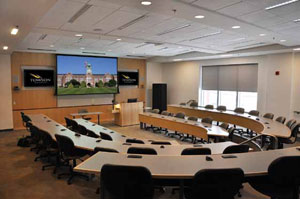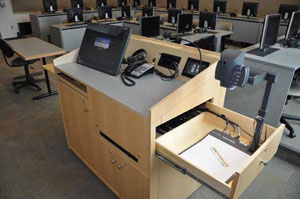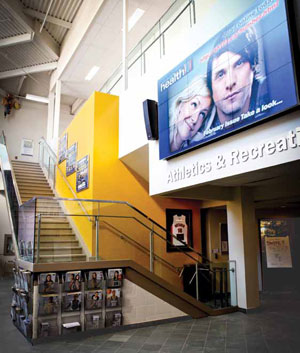School of Thought

Tech Managers Provide Lessons on AV Sales Priorities
The need for efficient notifications and emergency messaging has brought networked IP speaker systems such as Atlas Technologies’ I8SC into classrooms.
There are so many new ways for David Gross to access materials for his undergraduate and MBA students.
“We all use the internet to get information on corporations and on securities prices,” said Gross, senior instructor of finance at the Leeds School of Business, The University of Colorado, Boulder. “And where I used to have to describe spreadsheet modeling in an involved process on a blackboard, I now can post a spreadsheet on a course website for students to download so we can work on it at the same time. I’m able to do things using technology that I could not do 15 years ago. I can teach skills and techniques and refer to historic data in ways I never could before; it really makes a big difference.”
Gross embraces technologies in his classroom, but not all educators or school systems are alike. What suits one district or university may not be ideal for another. So what do educators really want and need, and what do consultants and integrators need to know when negotiating the education market?
Educators want a flexible product: they’re becoming savvier about technology and are being pushed by students’ needs, changing technology, and the need for distance and video-based learning, said Derrel Cone, project coordinator in technology solutions for the Kentucky Community and Technical College System (KCTCS) in Versailles, KY. KCTCS is composed of 16 colleges on 68 campuses and approximately 116,500,000 faculty, employees, and students.
Cone said integrators should realize that educational systems already have too many standalone learning systems. “Sometimes the projector is just an overhead projector, or it is just a whiteboard, or just a video. We need integrated solutions that put out quality high-definition video with quality sound that allows input and output to and from multiple resources. We want to meet the need for the new multimedia and technology savvy student. Using these expanded capabilities we extend our reach from the classroom to the living room with distance learning and beyond. And we need equipment that can get us there but will also serve additional purposes for notifications and emergency messaging.”
A daily selection of the top stories for AV integrators, resellers and consultants. Sign up below.
For the latter purpose, Cone said, “We’ve installed IP -based Atlas Technologies speaker systems which are connected to our emergency notification program we call SNAP, the System Notification Alert Process. In an emergency, SNAP uses Singlewire’s product InformaCast to send an emergency message to our VoIP phones and to desktop agents on select computers. The Atlas IP based speakers are used for locations where phones and computers are not located, such as halls, break rooms, and auditoriums. This allows us full internal coverage for broadcasting our emergency messages.”

Convergent Technologies Design Group installed Crestron RoomView at Towson University’s New Liberal Arts building.
Connected Classrooms
Teachers like technology because it helps keep students engaged, commented Elias Schwartz, electronic technician, Riverside CA Unified School District. The district maintains 54 K-12 sites. “But you really can see two different mentalities, the teachers who’ve been here for decades, and on the flip side, the younger generation who are ready to embrace anything. There’s no middle ground so it’s a love/hate of tech depending on the group.”
Riverside uses Atlas Technologies and InformaCast for intercom and bell systems, and from an operations perspective, Schwartz said, the district is just starting to scratch the technological surface with a goal of getting all sites moving together as a cohesive unit. “Most of our teachers are not very tech savvy,” he said. “They follow the tech as equipment is put into their rooms, and learn what they need to learn.
“Our hottest products are the interactive white board, from Promethean and others. That’s the hot tool because teachers can relay information based off set criteria and media supplied from the district rather than create their own lesson plans. It allows us to hand an electronic package from classroom to classroom.”
Know Your Customer
Integrators, Schwartz observed, hear about a project and send sales people that don’t always understand the particular district’s focus. “Product is great but doesn’t always address what we’re looking for. Ultimately, integrators should get to know what a particular district does; we’re a unique arm of the industry, and we don’t operate like any other facility.
“It’s important to understand the ‘who’ of the district as well. Some districts are techno geeks who will purchase leading-edge tech and others are still trying to figure out if there should be chalkboards in the classrooms.”

Educators want to be able to press a button without fumbling with cables or remotes.
For Mike Searight, director of information systems at McLennan Community College in Waco, TX, it’s about ease of use for instructors. “I buy directly from manufacturers and work with an integrator, and it’s nice to have an integrator come in and tell us what other colleges are doing.”
In the classroom, Searight said, “Our educators want to be able to press a button without fumbling with cables or remotes.” In the last two years, the college system purchased close to 120 Crestron MPS- 100, 200, and 300 multimedia presentation systems and Crestron’s FlipTop Touchpanel Control Center.
Wired Future
With 15 buildings on its main campus, McLennan serves 11,000 students on two campuses. A main academic center for liberal arts studies features Crestron and VBrick encoders for a lecture capture solution. Three miles away, a $10 million campus specializes in police, fire, and EMS training, has a lecture hall and 15 classrooms, all with Crestron integration.
Searight said an English division in the liberal arts building will be renovated with Crestron control systems in the near future. “We’re on the edge of VGA but digital media is the next thing and I want to make sure we don’t buy outdated technology. We’ve spent about two million on technology in last two years.

In some cases, Toronto’s Humber College uses the live video streaming capabilities of Omnivex software to show a live television feed of major events, such as college ceremonies, guest lecturers, coverage of elections, world news stories, and other important events.
McLennan also uses VBrick encoders and Camtasia software solutions. “Lecture capture, for snippets or whole lectures, posted to our blackboard course management system is important to us and is tied to higher student success rates, and we’re documenting that,” Searight explained. “Instructors love how the Crestron/VBrick system is to use. The Camtasia requires a little more effort and training on the instructional side but it still provides tremendous benefits for our students. A dream solution for me would be to see better quality video for all signal sources when recording.”
KTCTS, too, has plans in motion for new building designs, featuring full coverage using VoIP phones, computers, and IP -based speakers. “We also send out SNAP messages using phone calls, emails, text messages, and updates to Facebook and Twitter,” Cone said. “One new site being developed is the new campus for Bluegrass Community and Technical College (BCTC) in Lexington, KY. This campus will eventually serve approximately 6,000 students with the latest in technology.”
Cone said the school is looking at new Atlas IP speakers for classrooms that incorporate multi-functional use for multimedia and emergency and paging. “A speaker in the ceiling for our video projector, or on the wall for paging, and another one in the hall for emergency notification is not a practical use of funding. We have to incorporate all functions to make the best of the buck. KCTCS already uses multimedia-based smart technology in our classrooms. They are no longer just rooms with a whiteboard with an overhead projector; they are multimedia learning environments that can display content of all forms. And a dream system for our teachers would be one that’s easy to use and flexible enough to allow them to bring in multiple outside resources and to display various forms of internet, video, and other multimedia content that extends the concept of the whiteboard and overhead projector to the technology of today.”
The Riverside K-12 district, Schwartz noted, is blessed in that most of its teachers want to teach. “A dream system would allow them to put all the tools in one spot so they could choose the right tool on the fly. Out of all the methodologies, you never know which one will reach the students at that particular moment. If there was a way to get all of them into a computer so they could do this, that’s the future; one comprehensive package that allows this at a moment’s notice.”
Karen Mitchell is a freelance writer based in Boulder, CO.
